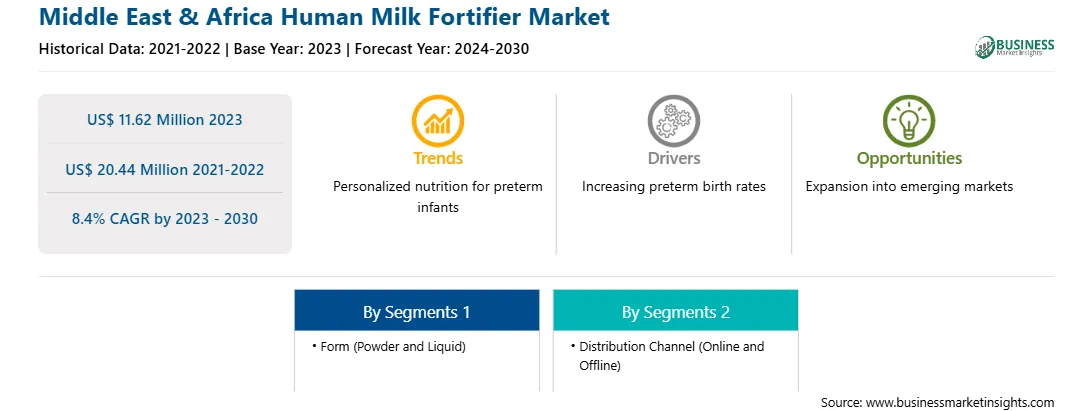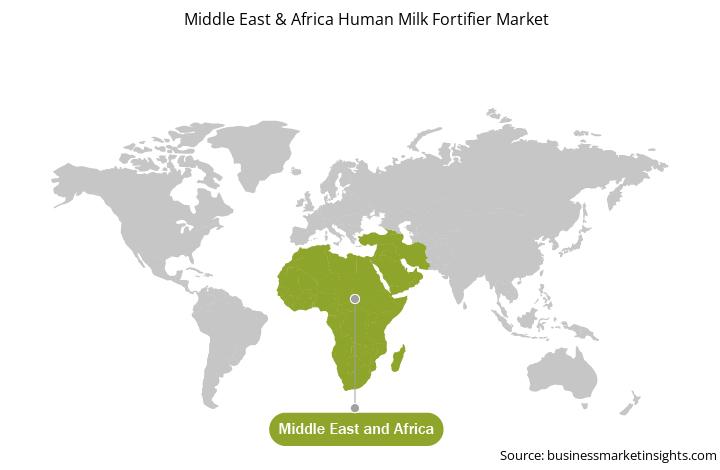In recent years, the number of preterm births has increased owing to changing lifestyles and chronic diseases such as diabetes and high blood pressure. According to United Nations agencies and partners, a projected 13.4 million babies were delivered preterm in 2020, with almost 1 million dying from problems related to preterm birth. This translates to roughly one in ten infants delivered prematurely (before 37 weeks of pregnancy) globally. Preterm babies may have breathing problems, feeding difficulties, development delays, and vision and hearing problems.
The increasing number of preterm births has surged the demand for human milk fortifiers for the proper growth and development of infants. Many preterm infants need extra nutrients added to their mother’s milk. They often need extra protein, calcium, phosphorous, and even salt to build strong bones and healthy organs. Human milk fortifiers help provide these extra nutrients to infants. In human milk fortifiers, additional nutrients are added to the milk before it is fed to the babies.
Thus, a surge in the number of preterm births is bolstering the Middle East & Africa human milk fortifier market growth.
Increasing awareness of the potential health complications associated with preterm births and rising preterm birth rates are surging the demand for human milk fortifiers in the region. Healthcare professionals and parents are recognizing the importance of fortifying breast milk to meet the nutritional needs of premature infants, which has led to a higher demand for human milk fortifiers.
Also, International organizations such as the World Health Organization (WHO) and the United Nations Children's Fund (UNICEF) have provided guidelines and recommendations for using human milk fortifiers in preterm infant care. The adoption of these guidelines by healthcare professionals in the Middle East & Africa has further contributed to the growth of the human milk fortifier market.
Strategic insights for the Middle East & Africa Human Milk Fortifier provides data-driven analysis of the industry landscape, including current trends, key players, and regional nuances. These insights offer actionable recommendations, enabling readers to differentiate themselves from competitors by identifying untapped segments or developing unique value propositions. Leveraging data analytics, these insights help industry players anticipate the market shifts, whether investors, manufacturers, or other stakeholders. A future-oriented perspective is essential, helping stakeholders anticipate market shifts and position themselves for long-term success in this dynamic region. Ultimately, effective strategic insights empower readers to make informed decisions that drive profitability and achieve their business objectives within the market.

| Report Attribute | Details |
|---|---|
| Market size in 2023 | US$ 11.62 Million |
| Market Size by 2030 | US$ 20.44 Million |
| CAGR (2023 - 2030) | 8.4% |
| Historical Data | 2021-2022 |
| Forecast period | 2024-2030 |
| Segments Covered |
By Form
|
| Regions and Countries Covered | Middle East and Africa
|
| Market leaders and key company profiles |
|
The geographic scope of the Middle East & Africa Human Milk Fortifier refers to the specific areas in which a business operates and competes. Understanding local distinctions, such as diverse consumer preferences (e.g., demand for specific plug types or battery backup durations), varying economic conditions, and regulatory environments, is crucial for tailoring strategies to specific markets. Businesses can expand their reach by identifying underserved areas or adapting their offerings to meet local demands. A clear market focus allows for more effective resource allocation, targeted marketing campaigns, and better positioning against local competitors, ultimately driving growth in those targeted areas.

Middle East & Africa Human Milk Fortifier Market Segmentation
The Middle East & Africa human milk fortifier market is segmented based on form, distribution channel, and country. Based on form, the Middle East & Africa human milk fortifier market is bifurcated into powder and liquid. The powder segment held a larger market share in 2023.
Based on distribution channel, the Middle East & Africa human milk fortifier market is bifurcated into online and offline. The offline segment held a larger market share in 2023.
Based on country, the Middle East & Africa human milk fortifier market is segmented into South Africa, Saudi Arabia, the UAE, and the Rest of Middle East & Africa. Saudi Arabia dominated the Middle East & Africa human milk fortifier market in 2023.
Abbott Laboratories, Nestle SA, Raptakos, Brett & Co Ltd, Danone SA, and Reckitt Benckiser Group Plc are some of the leading companies operating in the Middle East & Africa human milk fortifier market.
The Middle East & Africa Human Milk Fortifier Market is valued at US$ 11.62 Million in 2023, it is projected to reach US$ 20.44 Million by 2030.
As per our report Middle East & Africa Human Milk Fortifier Market, the market size is valued at US$ 11.62 Million in 2023, projecting it to reach US$ 20.44 Million by 2030. This translates to a CAGR of approximately 8.4% during the forecast period.
The Middle East & Africa Human Milk Fortifier Market report typically cover these key segments-
The historic period, base year, and forecast period can vary slightly depending on the specific market research report. However, for the Middle East & Africa Human Milk Fortifier Market report:
The Middle East & Africa Human Milk Fortifier Market is populated by several key players, each contributing to its growth and innovation. Some of the major players include:
The Middle East & Africa Human Milk Fortifier Market report is valuable for diverse stakeholders, including:
Essentially, anyone involved in or considering involvement in the Middle East & Africa Human Milk Fortifier Market value chain can benefit from the information contained in a comprehensive market report.